TABLE OF CONTENTS
1 INTRODUCTION (Page No. - 29)
1.1 STUDY OBJECTIVES
1.2 MARKET DEFINITION
1.2.1 BUILDING THERMAL INSULATION MARKET: INCLUSIONS AND EXCLUSIONS
1.2.2 BUILDING THERMAL INSULATION MARKET: DEFINITION AND INCLUSIONS, BY MATERIAL
1.2.3 BUILDING THERMAL INSULATION MARKET: DEFINITION AND INCLUSIONS, BY APPLICATION
1.2.4 BUILDING THERMAL INSULATION MARKET: DEFINITION AND INCLUSIONS, BY BUILDING TYPE
1.3 MARKET SCOPE
1.3.1 BUILDING THERMAL INSULATION MARKET SEGMENTATION
1.3.2 REGIONS COVERED
1.3.3 YEARS CONSIDERED
1.4 CURRENCY CONSIDERED
1.5 UNITS CONSIDERED
1.6 STAKEHOLDERS
1.7 SUMMARY OF CHANGES
1.7.1 IMPACT OF RECESSION
2 RESEARCH METHODOLOGY (Page No. - 35)
2.1 RESEARCH DATA
FIGURE 1 BUILDING THERMAL INSULATION MARKET: RESEARCH DESIGN
2.1.1 SECONDARY DATA
2.1.2 PRIMARY DATA
2.1.2.1 Interviews with experts–demand and supply sides
2.1.2.2 Key industry insights
2.1.2.3 Breakdown of primary interviews
2.2 MARKET SIZE ESTIMATION
2.2.1 BOTTOM-UP APPROACH
FIGURE 2 MARKET SIZE ESTIMATION METHODOLOGY: APPROACH 1 (SUPPLY SIDE)—COLLECTIVE SHARE OF KEY PLAYERS
FIGURE 3 MARKET SIZE ESTIMATION METHODOLOGY: APPROACH 2 (SUPPLY SIDE)—COLLECTIVE REVENUE OF ALL PRODUCTS
FIGURE 4 MARKET SIZE ESTIMATION METHODOLOGY: APPROACH 3 (DEMAND SIDE)—PRODUCTS SOLD
2.2.2 TOP-DOWN APPROACH
FIGURE 5 MARKET SIZE ESTIMATION METHODOLOGY: APPROACH 4 (TOP-DOWN)
2.3 DATA TRIANGULATION
FIGURE 6 BUILDING THERMAL INSULATION MARKET: DATA TRIANGULATION
2.4 GROWTH FORECAST
2.4.1 SUPPLY-SIDE ANALYSIS
FIGURE 7 MARKET GROWTH PROJECTION FROM SUPPLY SIDE
2.4.2 DEMAND-SIDE ANALYSIS
FIGURE 8 MARKET GROWTH PROJECTION FROM DEMAND-SIDE DRIVERS AND OPPORTUNITIES
2.5 FACTOR ANALYSIS
2.6 IMPACT OF RECESSION
2.7 ASSUMPTIONS
2.8 LIMITATIONS
2.9 RISK ASSESSMENT
3 EXECUTIVE SUMMARY (Page No. - 46)
FIGURE 9 PLASTIC FOAM ACCOUNTED FOR LARGEST MARKET SHARE IN 2022
FIGURE 10 WALL INSULATION TO LEAD BUILDING THERMAL INSULATION MARKET DURING FORECAST PERIOD
FIGURE 11 RESIDENTIAL SEGMENT TO LEAD BUILDING THERMAL INSULATION MARKET DURING FORECAST PERIOD
FIGURE 12 ASIA PACIFIC TO WITNESS HIGHEST CAGR DURING FORECAST PERIOD
4 PREMIUM INSIGHTS (Page No. - 50)
4.1 ATTRACTIVE OPPORTUNITIES FOR PLAYERS IN BUILDING THERMAL INSULATION MARKET
FIGURE 13 NON-RESIDENTIAL SEGMENT TO DRIVE MARKET DURING FORECAST PERIOD
4.2 BUILDING THERMAL INSULATION MARKET, BY REGION
FIGURE 14 ASIA PACIFIC TO WITNESS FASTEST GROWTH DURING FORECAST PERIOD
4.3 EUROPE BUILDING THERMAL INSULATION MARKET, BY COUNTRY AND MATERIAL
FIGURE 15 GERMANY ACCOUNTED FOR LARGEST MARKET SHARE IN 2022
4.4 BUILDING THERMAL INSULATION MARKET, BY BUILDING TYPE AND REGION
FIGURE 16 RESIDENTIAL SEGMENT ACCOUNTED FOR LARGER MARKET SHARE IN MOST REGIONS
4.5 BUILDING THERMAL INSULATION MARKET, BY KEY COUNTRIES
FIGURE 17 UAE TO REGISTER HIGHEST CAGR DURING FORECAST PERIOD
5 MARKET OVERVIEW (Page No. - 53)
5.1 INTRODUCTION
5.2 MARKET DYNAMICS
FIGURE 18 DRIVERS, RESTRAINTS, OPPORTUNITIES, AND CHALLENGES IN BUILDING THERMAL INSULATION MARKET
5.2.1 DRIVERS
5.2.1.1 Stringent regulations to reduce greenhouse gas emissions
TABLE 1 REGION-WISE REGULATIONS TO REDUCE GREENHOUSE GAS EMISSIONS
5.2.1.2 Development of green buildings
TABLE 2 LEED GREEN BUILDING CERTIFICATIONS, BY COUNTRY (2022)
5.2.1.3 Reduction in energy consumption and related costs
5.2.1.4 Rebates and tax credits
5.2.1.5 Stringent building energy codes
5.2.2 RESTRAINTS
5.2.2.1 Fluctuation in prices of plastic foam
5.2.2.2 Availability of green insulation materials
5.2.3 OPPORTUNITIES
5.2.3.1 High energy requirements
5.2.4 CHALLENGES
5.2.4.1 Lack of awareness about building thermal insulation
5.3 PORTER’S FIVE FORCES ANALYSIS
FIGURE 19 BUILDING THERMAL INSULATION MARKET: PORTER’S FIVE FORCES ANALYSIS
5.3.1 THREAT OF NEW ENTRANTS
5.3.2 THREAT OF SUBSTITUTES
5.3.3 BARGAINING POWER OF SUPPLIERS
5.3.4 BARGAINING POWER OF BUYERS
5.3.5 INTENSITY OF COMPETITIVE RIVALRY
TABLE 3 BUILDING THERMAL INSULATION MARKET: PORTER’S FIVE FORCES ANALYSIS
5.4 MACROECONOMIC INDICATORS
5.4.1 GDP TRENDS AND FORECASTS OF MAJOR ECONOMIES
TABLE 4 GDP TRENDS AND FORECAST, BY MAJOR ECONOMIES, 2020–2028 (USD BILLION)
6 INDUSTRY TRENDS (Page No. - 62)
6.1 SUPPLY CHAIN ANALYSIS
FIGURE 20 BUILDING THERMAL INSULATION: SUPPLY CHAIN
6.1.1 RAW MATERIALS
6.1.2 MANUFACTURING
6.1.3 DISTRIBUTION NETWORK
6.1.4 APPLICATION
6.2 KEY STAKEHOLDERS AND BUYING CRITERIA
6.2.1 KEY STAKEHOLDERS IN BUYING PROCESS
FIGURE 21 INFLUENCE OF STAKEHOLDERS ON BUYING PROCESS IN TOP THREE APPLICATIONS
TABLE 5 INFLUENCE OF STAKEHOLDERS ON BUYING PROCESS IN TOP THREE APPLICATIONS (%)
6.2.2 BUYING CRITERIA
FIGURE 22 KEY BUYING CRITERIA FOR TOP THREE APPLICATIONS
TABLE 6 KEY BUYING CRITERIA FOR TOP THREE APPLICATIONS
6.3 TRENDS/DISRUPTIONS IMPACTING CUSTOMER BUSINESS
FIGURE 23 TRENDS/DISRUPTIONS IMPACTING CUSTOMER BUSINESS
6.4 ECOSYSTEM ANALYSIS
FIGURE 24 ECOSYSTEM OF BUILDING THERMAL INSULATION MARKET
TABLE 7 BUILDING THERMAL INSULATION MARKET: ROLE IN ECOSYSTEM
6.5 CASE STUDIES
6.5.1 ENHANCING COMMUNITY WELL-BEING: WILMCOTE HOUSE'S THERMAL EFFICIENCY UPGRADE
6.6 TECHNOLOGY ANALYSIS
6.6.1 KEY TECHNOLOGIES
6.6.1.1 XPS foam technology
TABLE 8 ADVANTAGES OF XPS FOAM TECHNOLOGY
6.6.1.2 ECOSE technology
TABLE 9 BENEFITS OF ECOSE TECHNOLOGY
6.6.2 COMPLEMENTARY TECHNOLOGIES
6.6.2.1 Air sealing
6.6.2.2 Reflective roofing materials
6.7 PRICING ANALYSIS
6.7.1 AVERAGE SELLING PRICE TREND OF KEY PLAYERS, BY APPLICATION
FIGURE 25 AVERAGE SELLING PRICE TREND OF KEY PLAYERS, BY APPLICATION
TABLE 10 AVERAGE SELLING PRICE TREND OF KEY PLAYERS, BY APPLICATION (USD/KG)
6.7.2 AVERAGE SELLING PRICE TREND, BY REGION
FIGURE 26 AVERAGE SELLING PRICE TREND OF BUILDING THERMAL INSULATION, BY REGION (USD/KG)
TABLE 11 AVERAGE SELLING PRICE TREND OF BUILDING THERMAL INSULATION, BY REGION (USD/KG)
6.8 TRADE ANALYSIS
6.8.1 IMPORT SCENARIO OF BUILDING THERMAL INSULATION
FIGURE 27 IMPORT OF BUILDING THERMAL INSULATION, BY KEY COUNTRIES (2017–2022)
TABLE 12 IMPORT OF BUILDING THERMAL INSULATION, BY REGION, 2017–2022 (USD MILLION)
6.8.2 EXPORT SCENARIO OF BUILDING THERMAL INSULATION
FIGURE 28 EXPORT OF BUILDING THERMAL INSULATION, BY KEY COUNTRIES (2017−2022)
TABLE 13 EXPORT OF BUILDING THERMAL INSULATION, BY REGION, 2017–2022 (USD MILLION)
6.9 REGULATORY LANDSCAPE
TABLE 14 NORTH AMERICA: REGULATIONS FOR BUILDING THERMAL INSULATION
TABLE 15 EUROPE: REGULATIONS FOR BUILDING THERMAL INSULATION
TABLE 16 ASIA PACIFIC: REGULATIONS FOR BUILDING THERMAL INSULATION
6.9.1 REGULATORY BODIES, GOVERNMENT AGENCIES, AND OTHER ORGANIZATIONS
6.10 KEY CONFERENCES AND EVENTS IN 2024–2025
TABLE 17 BUILDING THERMAL INSULATION MARKET: KEY CONFERENCES AND EVENTS
6.11 INVESTMENT AND FUNDING SCENARIO
6.12 PATENT ANALYSIS
6.12.1 APPROACH
6.12.2 DOCUMENT TYPE
TABLE 18 PATENT STATUS: PATENT APPLICATIONS, LIMITED PATENTS, AND GRANTED PATENTS
FIGURE 29 PATENTS REGISTERED IN BUILDING THERMAL INSULATION, 2012–2023
FIGURE 30 LIST OF MAJOR PATENTS FOR BUILDING THERMAL INSULATION
6.12.3 TOP APPLICANTS
TABLE 19 LIST OF MAJOR PATENTS OF BUILDING THERMAL INSULATION
TABLE 20 PATENTS BY INEOS STATE GRID CORPORATION OF CHINA
TABLE 21 PATENTS BY BASF SE
TABLE 22 PATENTS BY SAMSUNG ELECTRONICS CO., LTD.
TABLE 23 TOP 10 PATENT OWNERS IN CHINA, 2012–2023
FIGURE 31 LEGAL STATUS OF PATENTS FILED IN BUILDING THERMAL INSULATION MARKET
6.12.4 JURISDICTION ANALYSIS
FIGURE 32 MAXIMUM PATENTS FILED IN JURISDICTION OF CHINA
7 BUILDING THERMAL INSULATION MARKET, BY MATERIAL (Page No. - 88)
7.1 INTRODUCTION
TABLE 24 MATERIALS AND THEIR APPLICATIONS
TABLE 25 OPERATIONAL TEMPERATURE RANGES OF DIFFERENT MATERIALS
TABLE 26 R-VALUE OF DIFFERENT MATERIALS
FIGURE 33 PLASTIC FOAM TO ACCOUNT FOR LARGEST SHARE OF BUILDING THERMAL INSULATION MARKET
TABLE 27 BUILDING THERMAL INSULATION MARKET, BY MATERIAL, 2017–2022 (USD MILLION)
TABLE 28 BUILDING THERMAL INSULATION MARKET, BY MATERIAL, 2023–2028 (USD MILLION)
TABLE 29 BUILDING THERMAL INSULATION MARKET, BY MATERIAL, 2017–2022 (KILOTON)
TABLE 30 BUILDING THERMAL INSULATION MARKET, BY MATERIAL, 2023–2028 (KILOTON)
7.2 PLASTIC FOAM
7.2.1 GROWTH IN BUILDING & CONSTRUCTION INDUSTRY TO INCREASED DEMAND FOR PLASTIC FOAM
FIGURE 34 ASIA PACIFIC TO BE LARGEST MARKET FOR PLASTIC FOAM SEGMENT DURING FORECAST PERIOD
TABLE 31 PLASTIC FOAM: BUILDING THERMAL INSULATION MARKET, BY REGION, 2017–2022 (USD MILLION)
TABLE 32 PLASTIC FOAM: BUILDING THERMAL INSULATION MARKET, BY REGION, 2023–2028 (USD MILLION)
TABLE 33 PLASTIC FOAM: BUILDING THERMAL INSULATION MARKET, BY REGION, 2017–2022 (KILOTON)
TABLE 34 PLASTIC FOAM: BUILDING THERMAL INSULATION MARKET, BY REGION, 2023–2028 (KILOTON)
TABLE 35 PLASTIC FOAM: BUILDING THERMAL INSULATION MARKET, BY SUB-TYPE, 2017–2022 (USD MILLION)
TABLE 36 PLASTIC FOAM: BUILDING THERMAL INSULATION MARKET, BY SUB-TYPE, 2023–2028 (USD MILLION)
TABLE 37 PLASTIC FOAM: BUILDING THERMAL INSULATION MARKET, BY SUB-TYPE, 2017–2022 (KILOTON)
TABLE 38 PLASTIC FOAM: BUILDING THERMAL INSULATION MARKET, BY SUB-TYPE, 2023–2028 (KILOTON)
7.2.2 POLYSTYRENE FOAM
7.2.2.1 Expanded polystyrene (EPS) foam
7.2.2.2 Extruded polystyrene (XPS) foam
TABLE 39 POLYSTYRENE FOAM: BUILDING THERMAL INSULATION MARKET, BY REGION, 2017–2022 (USD MILLION)
TABLE 40 POLYSTYRENE FOAM: BUILDING THERMAL INSULATION MARKET, BY REGION, 2023–2028 (USD MILLION)
TABLE 41 POLYSTYRENE FOAM: BUILDING THERMAL INSULATION MARKET, BY REGION, 2017–2022 (KILOTON)
TABLE 42 POLYSTYRENE FOAM: BUILDING THERMAL INSULATION MARKET, BY REGION, 2023–2028 (KILOTON)
7.2.3 POLYURETHANE (PUR) & POLYISOCYANURATE (PIR) FOAM
TABLE 43 PUR & PIR FOAM: BUILDING THERMAL INSULATION MARKET, BY REGION, 2017–2022 (USD MILLION)
TABLE 44 PUR & PIR FOAM: BUILDING THERMAL INSULATION MARKET, BY REGION, 2023–2028 (USD MILLION)
TABLE 45 PUR & PIR FOAM: BUILDING THERMAL INSULATION MARKET, BY REGION, 2017–2022 (KILOTON)
TABLE 46 PUR & PIR FOAM: BUILDING THERMAL INSULATION MARKET, BY REGION, 2023–2028 (KILOTON)
7.2.4 OTHER PLASTIC FOAMS
7.2.4.1 Phenolic foam
7.2.4.2 Elastomeric foam
TABLE 47 OTHER PLASTIC FOAMS: BUILDING THERMAL INSULATION MARKET, BY REGION, 2017–2022 (USD MILLION)
TABLE 48 OTHER PLASTIC FOAMS: BUILDING THERMAL INSULATION MARKET, BY REGION, 2023–2028 (USD MILLION)
TABLE 49 OTHER PLASTIC FOAMS: BUILDING THERMAL INSULATION MARKET, BY REGION, 2017–2022 (KILOTON)
TABLE 50 OTHER PLASTIC FOAMS: BUILDING THERMAL INSULATION MARKET, BY REGION, 2023–2028 (KILOTON)
7.3 GLASS WOOL
7.3.1 LIGHTWEIGHT, NON-COMBUSTIBLE, HIGH TEAR STRENGTH, AND CORROSION-RESISTANT PROPERTIES TO DRIVE DEMAND
FIGURE 35 NORTH AMERICA TO LEAD GLASS WOOL SEGMENT DURING FORECAST PERIOD
TABLE 51 GLASS WOOL: BUILDING THERMAL INSULATION MARKET, BY REGION, 2017–2022 (USD MILLION)
TABLE 52 GLASS WOOL: BUILDING THERMAL INSULATION MARKET, BY REGION, 2023–2028 (USD MILLION)
TABLE 53 GLASS WOOL: BUILDING THERMAL INSULATION MARKET, BY REGION, 2017–2022 (KILOTON)
TABLE 54 GLASS WOOL: BUILDING THERMAL INSULATION MARKET, BY REGION, 2023–2028 (KILOTON)
7.4 STONE WOOL
7.4.1 GROWTH OF CONSTRUCTION & ARCHITECTURAL SECTORS FUELING MARKET GROWTH
FIGURE 36 EUROPE TO LEAD STONE WOOL SEGMENT DURING FORECAST PERIOD
TABLE 55 STONE WOOL: BUILDING THERMAL INSULATION MARKET, BY REGION, 2017–2022 (USD MILLION)
TABLE 56 STONE WOOL: BUILDING THERMAL INSULATION MARKET, BY REGION, 2023–2028 (USD MILLION)
TABLE 57 STONE WOOL: BUILDING THERMAL INSULATION MARKET, BY REGION, 2017–2022 (KILOTON)
TABLE 58 STONE WOOL: BUILDING THERMAL INSULATION MARKET, BY REGION, 2023–2028 (KILOTON)
7.5 OTHER MATERIALS
7.5.1 AEROGEL
7.5.2 CELLULOSE
7.5.3 CELLULAR GLASS
FIGURE 37 EUROPE TO LEAD OTHER MATERIALS SEGMENT DURING FORECAST PERIOD
TABLE 59 OTHER MATERIALS: BUILDING THERMAL INSULATION MARKET, BY REGION, 2017–2022 (USD MILLION)
TABLE 60 OTHER MATERIALS: BUILDING THERMAL INSULATION MARKET, BY REGION, 2023–2028 (USD MILLION)
TABLE 61 OTHER MATERIALS: BUILDING THERMAL INSULATION MARKET, BY REGION, 2017–2022 (KILOTON)
TABLE 62 OTHER MATERIALS: BUILDING THERMAL INSULATION MARKET, BY REGION, 2023–2028 (KILOTON)
8 BUILDING THERMAL INSULATION MARKET, BY BUILDING TYPE (Page No. - 108)
8.1 INTRODUCTION
FIGURE 38 RESIDENTIAL SEGMENT TO ACCOUNT FOR LARGER SHARE OF BUILDING THERMAL INSULATION MARKET DURING FORECAST PERIOD
TABLE 63 BUILDING THERMAL INSULATION MARKET, BY BUILDING TYPE, 2017–2022 (USD MILLION)
TABLE 64 BUILDING THERMAL INSULATION MARKET, BY BUILDING TYPE, 2023–2028 (USD MILLION)
TABLE 65 BUILDING THERMAL INSULATION MARKET, BY BUILDING TYPE, 2017–2022 (KILOTON)
TABLE 66 BUILDING THERMAL INSULATION MARKET, BY BUILDING TYPE, 2023–2028 (KILOTON)
8.2 NON-RESIDENTIAL BUILDING
8.2.1 ROBUST MANUFACTURING AND INCREASE IN INDUSTRIAL ACTIVITIES TO DRIVE MARKET
8.2.2 INDUSTRIAL BUILDINGS
8.2.3 COMMERCIAL BUILDINGS
8.2.4 OTHERS
FIGURE 39 ASIA PACIFIC TO WITNESS HIGHEST CAGR IN NON-RESIDENTIAL BUILDING SEGMENT DURING FORECAST PERIOD
TABLE 67 BUILDING THERMAL INSULATION MARKET IN NON-RESIDENTIAL BUILDING, BY REGION, 2017–2022 (USD MILLION)
TABLE 68 BUILDING THERMAL INSULATION MARKET IN NON-RESIDENTIAL BUILDING, BY REGION, 2023–2028 (USD MILLION)
TABLE 69 BUILDING THERMAL INSULATION MARKET IN NON-RESIDENTIAL BUILDING, BY REGION, 2017–2022 (KILOTON)
TABLE 70 BUILDING THERMAL INSULATION MARKET IN NON-RESIDENTIAL BUILDING, BY REGION, 2023–2028 (KILOTON)
8.3 RESIDENTIAL BUILDING
8.3.1 URBANIZATION AND GOVERNMENT REGULATIONS ON ENERGY-EFFICIENT BUILDINGS TO FUEL DEMAND
FIGURE 40 EUROPE TO LEAD MARKET IN RESIDENTIAL SEGMENT DURING FORECAST PERIOD
TABLE 71 BUILDING THERMAL INSULATION MARKET IN RESIDENTIAL BUILDING, BY REGION, 2017–2022 (USD MILLION)
TABLE 72 BUILDING THERMAL INSULATION MARKET IN RESIDENTIAL BUILDING, BY REGION, 2023–2028 (USD MILLION)
TABLE 73 BUILDING THERMAL INSULATION MARKET IN RESIDENTIAL BUILDING, BY REGION, 2017–2022 (KILOTON)
TABLE 74 BUILDING THERMAL INSULATION MARKET IN RESIDENTIAL BUILDING, BY REGION, 2023–2028 (KILOTON)
9 BUILDING THERMAL INSULATION MARKET, BY APPLICATION (Page No. - 115)
9.1 INTRODUCTION
FIGURE 41 PERCENTAGE OF ENERGY LOSS IN BUILDINGS
FIGURE 42 ROOF INSULATION TO BE FASTEST-GROWING APPLICATION OF BUILDING THERMAL INSULATION
TABLE 75 BUILDING THERMAL INSULATION MARKET, BY APPLICATION, 2017–2022 (USD MILLION)
TABLE 76 BUILDING THERMAL INSULATION MARKET, BY APPLICATION, 2023–2028 (USD MILLION)
TABLE 77 BUILDING THERMAL INSULATION MARKET, BY APPLICATION, 2017–2022 (KILOTON)
TABLE 78 BUILDING THERMAL INSULATION MARKET, BY APPLICATION, 2023–2028 (KILOTON)
9.2 WALL INSULATION
9.2.1 EXTERNAL WALLS TO DOMINATE MARKET IN WALL INSULATION SEGMENT
FIGURE 43 EXTERNAL WALL TO ACCOUNT FOR LARGEST SHARE IN WALL INSULATION APPLICATION DURING FORECAST PERIOD
9.2.2 EXTERNAL WALL INSULATION
9.2.3 INTERNAL WALL INSULATION
9.2.4 CAVITY WALL INSULATION
TABLE 79 BUILDING THERMAL INSULATION MARKET IN WALL INSULATION, BY SUB-APPLICATION, 2017–2022 (USD MILLION)
TABLE 80 BUILDING THERMAL INSULATION MARKET IN WALL INSULATION, BY SUB-APPLICATION, 2023–2028 (USD MILLION)
TABLE 81 BUILDING THERMAL INSULATION MARKET IN WALL INSULATION, BY SUB-APPLICATION, 2017–2022 (KILOTON)
TABLE 82 BUILDING THERMAL INSULATION MARKET IN WALL INSULATION, BY SUB-APPLICATION, 2023–2028 (KILOTON)
9.3 ROOF INSULATION
9.3.1 INCREASE IN CONSTRUCTION ACTIVITIES TO DRIVE MARKET
FIGURE 44 FLAT ROOF TO ACCOUNT FOR LARGER SHARE IN ROOF INSULATION APPLICATION DURING FORECAST PERIOD
9.3.2 FLAT ROOF INSULATION
9.3.3 PITCHED ROOF INSULATION
TABLE 83 BUILDING THERMAL INSULATION MARKET IN ROOF INSULATION, BY SUB-APPLICATION, 2017–2022 (USD MILLION)
TABLE 84 BUILDING THERMAL INSULATION MARKET IN ROOF INSULATION, BY SUB-APPLICATION, 2023–2028 (USD MILLION)
TABLE 85 BUILDING THERMAL INSULATION MARKET IN ROOF INSULATION, BY SUB-APPLICATION, 2017–2022 (KILOTON)
TABLE 86 BUILDING THERMAL INSULATION MARKET IN ROOF INSULATION, BY SUB-APPLICATION, 2023–2028 (KILOTON)
9.4 FLOOR INSULATION
9.4.1 HIGH QUALITY AND TECHNOLOGICAL ADVANCEMENTS DRIVING DEMAND
10 BUILDING THERMAL INSULATION MARKET, BY REGION (Page No. - 123)
10.1 INTRODUCTION
FIGURE 45 ASIA PACIFIC TO BE FASTEST-GROWING BUILDING THERMAL INSULATION MARKET BETWEEN 2023 AND 2028
TABLE 87 BUILDING THERMAL INSULATION MARKET, BY REGION, 2017–2022 (USD MILLION)
TABLE 88 BUILDING THERMAL INSULATION MARKET, BY REGION, 2023–2028 (USD MILLION)
TABLE 89 BUILDING THERMAL INSULATION MARKET, BY REGION, 2017–2022 (KILOTON)
TABLE 90 BUILDING THERMAL INSULATION MARKET, BY REGION, 2023–2028 (KILOTON)
10.2 EUROPE
FIGURE 46 EUROPE: BUILDING THERMAL INSULATION MARKET SNAPSHOT
10.2.1 IMPACT OF RECESSION ON EUROPE
10.2.2 EUROPE BUILDING THERMAL INSULATION MARKET, BY MATERIAL
TABLE 91 EUROPE: BUILDING THERMAL INSULATION MARKET, BY MATERIAL, 2017–2022 (USD MILLION)
TABLE 92 EUROPE: BUILDING THERMAL INSULATION MARKET, BY MATERIAL, 2023–2028 (USD MILLION)
TABLE 93 EUROPE: BUILDING THERMAL INSULATION MARKET, BY MATERIAL, 2017–2022 (KILOTON)
TABLE 94 EUROPE: BUILDING THERMAL INSULATION MARKET, BY MATERIAL, 2023–2028 (KILOTON)
10.2.3 EUROPE BUILDING THERMAL INSULATION MARKET, BY BUILDING TYPE
TABLE 95 EUROPE: BUILDING THERMAL INSULATION MARKET, BY BUILDING TYPE, 2017–2022 (USD MILLION)
TABLE 96 EUROPE: BUILDING THERMAL INSULATION MARKET, BY BUILDING TYPE, 2023–2028 (USD MILLION)
TABLE 97 EUROPE: BUILDING THERMAL INSULATION MARKET, BY BUILDING TYPE, 2017–2022 (KILOTON)
TABLE 98 EUROPE: BUILDING THERMAL INSULATION MARKET, BY BUILDING TYPE, 2023–2028 (KILOTON)
10.2.4 EUROPE BUILDING THERMAL INSULATION MARKET, BY COUNTRY
TABLE 99 EUROPE: BUILDING THERMAL INSULATION MARKET, BY COUNTRY, 2017–2022 (USD MILLION)
TABLE 100 EUROPE: BUILDING THERMAL INSULATION MARKET, BY COUNTRY, 2023–2028 (USD MILLION)
TABLE 101 EUROPE: BUILDING THERMAL INSULATION MARKET, BY COUNTRY, 2017–2022 (KILOTON)
TABLE 102 EUROPE: BUILDING THERMAL INSULATION MARKET, BY COUNTRY, 2023–2028 (KILOTON)
10.2.4.1 Germany
10.2.4.1.1 Investments in residential segment and green building labeling systems to drive market
TABLE 103 GERMANY: BUILDING THERMAL INSULATION MARKET, BY MATERIAL, 2017–2022 (USD MILLION)
TABLE 104 GERMANY: BUILDING THERMAL INSULATION MARKET, BY MATERIAL, 2023–2028 (USD MILLION)
TABLE 105 GERMANY: BUILDING THERMAL INSULATION MARKET, BY MATERIAL, 2017–2022 (KILOTON)
TABLE 106 GERMANY: BUILDING THERMAL INSULATION MARKET, BY MATERIAL, 2023–2028 (KILOTON)
10.2.4.2 France
10.2.4.2.1 Government regulations and presence of established companies to support market growth
TABLE 107 FRANCE: BUILDING THERMAL INSULATION MARKET, BY MATERIAL, 2017–2022 (USD MILLION)
TABLE 108 FRANCE: BUILDING THERMAL INSULATION MARKET, BY MATERIAL, 2023–2028 (USD MILLION)
TABLE 109 FRANCE: BUILDING THERMAL INSULATION MARKET, BY MATERIAL, 2017–2022 (KILOTON)
TABLE 110 FRANCE: BUILDING THERMAL INSULATION MARKET, BY MATERIAL, 2023–2028 (KILOTON)
10.2.4.3 Poland
10.2.4.3.1 Stringent building codes and increasing construction activities to drive demand
TABLE 111 POLAND: BUILDING THERMAL INSULATION MARKET, BY MATERIAL, 2017–2022 (USD MILLION)
TABLE 112 POLAND: BUILDING THERMAL INSULATION MARKET, BY MATERIAL, 2023–2028 (USD MILLION)
TABLE 113 POLAND: BUILDING THERMAL INSULATION MARKET, BY MATERIAL, 2017–2022 (KILOTON)
TABLE 114 POLAND: BUILDING THERMAL INSULATION MARKET, BY MATERIAL, 2023–2028 (KILOTON)
10.2.4.4 UK
10.2.4.4.1 Green building council and investments in construction to fuel demand
TABLE 115 UK: BUILDING THERMAL INSULATION MARKET, BY MATERIAL, 2017–2022 (USD MILLION)
TABLE 116 UK: BUILDING THERMAL INSULATION MARKET, BY MATERIAL, 2023–2028 (USD MILLION)
TABLE 117 UK: BUILDING THERMAL INSULATION MARKET, BY MATERIAL, 2017–2022 (KILOTON)
TABLE 118 UK: BUILDING THERMAL INSULATION MARKET, BY MATERIAL, 2023–2028 (KILOTON)
10.2.4.5 Italy
10.2.4.5.1 New project finance rules and investment policies to support market growth
TABLE 119 ITALY: BUILDING THERMAL INSULATION MARKET, BY MATERIAL, 2017–2022 (USD MILLION)
TABLE 120 ITALY: BUILDING THERMAL INSULATION MARKET, BY MATERIAL, 2023–2028 (USD MILLION)
TABLE 121 ITALY: BUILDING THERMAL INSULATION MARKET, BY MATERIAL, 2017–2022 (KILOTON)
TABLE 122 ITALY: BUILDING THERMAL INSULATION MARKET, BY MATERIAL, 2023–2028 (KILOTON)
10.2.4.6 Russia
10.2.4.6.1 Glass wool to be fastest-growing segment during forecast period
TABLE 123 RUSSIA: BUILDING THERMAL INSULATION MARKET, BY MATERIAL, 2017–2022 (USD MILLION)
TABLE 124 RUSSIA: BUILDING THERMAL INSULATION MARKET, BY MATERIAL, 2023–2028 (USD MILLION)
TABLE 125 RUSSIA: BUILDING THERMAL INSULATION MARKET, BY MATERIAL, 2017–2022 (KILOTON)
TABLE 126 RUSSIA: BUILDING THERMAL INSULATION MARKET, BY MATERIAL, 2023–2028 (KILOTON)
10.2.4.7 Spain
10.2.4.7.1 Strict building codes and increased consumer spending to drive demand
TABLE 127 SPAIN: BUILDING THERMAL INSULATION MARKET, BY MATERIAL, 2017–2022 (USD MILLION)
TABLE 128 SPAIN: BUILDING THERMAL INSULATION MARKET, BY MATERIAL, 2023–2028 (USD MILLION)
TABLE 129 SPAIN: BUILDING THERMAL INSULATION MARKET, BY MATERIAL, 2017–2022 (KILOTON)
TABLE 130 SPAIN: BUILDING THERMAL INSULATION MARKET, BY MATERIAL, 2023–2028 (KILOTON)
10.3 ASIA PACIFIC
FIGURE 47 ASIA PACIFIC: BUILDING THERMAL INSULATION MARKET SNAPSHOT
10.3.1 IMPACT OF RECESSION ON ASIA PACIFIC
10.3.2 ASIA PACIFIC BUILDING THERMAL INSULATION MARKET, BY MATERIAL
TABLE 131 ASIA PACIFIC: BUILDING THERMAL INSULATION MARKET, BY MATERIAL, 2017–2022 (USD MILLION)
TABLE 132 ASIA PACIFIC: BUILDING THERMAL INSULATION MARKET, BY MATERIAL, 2023–2028 (USD MILLION)
TABLE 133 ASIA PACIFIC: BUILDING THERMAL INSULATION MARKET, BY MATERIAL, 2017–2022 (KILOTON)
TABLE 134 ASIA PACIFIC: BUILDING THERMAL INSULATION MARKET, BY MATERIAL, 2023–2028 (KILOTON)
10.3.3 ASIA PACIFIC BUILDING THERMAL INSULATION MARKET, BY BUILDING TYPE
TABLE 135 ASIA PACIFIC: BUILDING THERMAL INSULATION MARKET, BY BUILDING TYPE, 2017–2022 (USD MILLION)
TABLE 136 ASIA PACIFIC: BUILDING THERMAL INSULATION MARKET, BY BUILDING TYPE, 2023–2028 (USD MILLION)
TABLE 137 ASIA PACIFIC: BUILDING THERMAL INSULATION MARKET, BY BUILDING TYPE, 2017–2022 (KILOTON)
TABLE 138 ASIA PACIFIC: BUILDING THERMAL INSULATION MARKET, BY BUILDING TYPE, 2023–2028 (KILOTON)
10.3.4 ASIA PACIFIC BUILDING THERMAL INSULATION MARKET, BY COUNTRY
TABLE 139 ASIA PACIFIC: BUILDING THERMAL INSULATION MARKET, BY COUNTRY, 2017–2022 (USD MILLION)
TABLE 140 ASIA PACIFIC: BUILDING THERMAL INSULATION MARKET, BY COUNTRY, 2023–2028 (USD MILLION)
TABLE 141 ASIA PACIFIC: BUILDING THERMAL INSULATION MARKET, BY COUNTRY, 2017–2022 (KILOTON)
TABLE 142 ASIA PACIFIC: BUILDING THERMAL INSULATION MARKET, BY COUNTRY, 2023–2028 (KILOTON)
10.3.4.1 China
10.3.4.1.1 Mandatory building energy codes for commercial and residential buildings to drive demand
TABLE 143 CHINA: BUILDING THERMAL INSULATION MARKET, BY MATERIAL, 2017–2022 (USD MILLION)
TABLE 144 CHINA: BUILDING THERMAL INSULATION MARKET, BY MATERIAL, 2023–2028 (USD MILLION)
TABLE 145 CHINA: BUILDING THERMAL INSULATION MARKET, BY MATERIAL, 2017–2022 (KILOTON)
TABLE 146 CHINA: BUILDING THERMAL INSULATION MARKET, BY MATERIAL, 2023–2028 (KILOTON)
10.3.4.2 Japan
10.3.4.2.1 Plastic foam to dominate market during forecast period
TABLE 147 JAPAN: BUILDING THERMAL INSULATION MARKET, BY MATERIAL, 2017–2022 (USD MILLION)
TABLE 148 JAPAN: BUILDING THERMAL INSULATION MARKET, BY MATERIAL, 2023–2028 (USD MILLION)
TABLE 149 JAPAN: BUILDING THERMAL INSULATION MARKET, BY MATERIAL, 2017–2022 (KILOTON)
TABLE 150 JAPAN: BUILDING THERMAL INSULATION MARKET, BY MATERIAL, 2023–2028 (KILOTON)
10.3.4.3 India
10.3.4.3.1 Economic growth and government initiatives to support market growth
TABLE 151 INDIA: BUILDING THERMAL INSULATION MARKET, BY MATERIAL, 2017–2022 (USD MILLION)
TABLE 152 INDIA: BUILDING THERMAL INSULATION MARKET, BY MATERIAL, 2023–2028 (USD MILLION)
TABLE 153 INDIA: BUILDING THERMAL INSULATION MARKET, BY MATERIAL, 2017–2022 (KILOTON)
TABLE 154 INDIA: BUILDING THERMAL INSULATION MARKET, BY MATERIAL, 2023–2028 (KILOTON)
10.3.4.4 South Korea
10.3.4.4.1 Green building certification rating and certification systems to support market growth
TABLE 155 SOUTH KOREA: BUILDING THERMAL INSULATION MARKET, BY MATERIAL, 2017–2022 (USD MILLION)
TABLE 156 SOUTH KOREA: BUILDING THERMAL INSULATION MARKET, BY MATERIAL, 2023–2028 (USD MILLION)
TABLE 157 SOUTH KOREA: BUILDING THERMAL INSULATION MARKET, BY MATERIAL, 2017–2022 (KILOTON)
TABLE 158 SOUTH KOREA: BUILDING THERMAL INSULATION MARKET, BY MATERIAL, 2023–2028 (KILOTON)
10.3.4.5 Thailand
10.3.4.5.1 Growth in tourism sector fueling demand
TABLE 159 THAILAND: BUILDING THERMAL INSULATION MARKET, BY MATERIAL, 2017–2022 (USD MILLION)
TABLE 160 THAILAND: BUILDING THERMAL INSULATION MARKET, BY MATERIAL, 2023–2028 (USD MILLION)
TABLE 161 THAILAND: BUILDING THERMAL INSULATION MARKET, BY MATERIAL, 2017–2022 (KILOTON)
TABLE 162 THAILAND: BUILDING THERMAL INSULATION MARKET, BY MATERIAL, 2023–2028 (KILOTON)
10.3.4.6 Malaysia
10.3.4.6.1 Government’s approach to green features in buildings to support market
TABLE 163 MALAYSIA: BUILDING THERMAL INSULATION MARKET, BY MATERIAL, 2017–2022 (USD MILLION)
TABLE 164 MALAYSIA: BUILDING THERMAL INSULATION MARKET, BY MATERIAL, 2023–2028 (USD MILLION)
TABLE 165 MALAYSIA: BUILDING THERMAL INSULATION MARKET, BY MATERIAL, 2017–2022 (KILOTON)
TABLE 166 MALAYSIA: BUILDING THERMAL INSULATION MARKET, BY MATERIAL, 2023–2028 (KILOTON)
10.3.4.7 Indonesia
10.3.4.7.1 Implementation of building energy codes to drive market
TABLE 167 INDONESIA: BUILDING THERMAL INSULATION MARKET, BY MATERIAL, 2017–2022 (USD MILLION)
TABLE 168 INDONESIA: BUILDING THERMAL INSULATION MARKET, BY MATERIAL, 2023–2028 (USD MILLION)
TABLE 169 INDONESIA: BUILDING THERMAL INSULATION MARKET, BY MATERIAL, 2017–2022 (KILOTON)
TABLE 170 INDONESIA: BUILDING THERMAL INSULATION MARKET, BY MATERIAL, 2023–2028 (KILOTON)
10.4 NORTH AMERICA
FIGURE 48 NORTH AMERICA: BUILDING THERMAL INSULATION MARKET SNAPSHOT
10.4.1 IMPACT OF RECESSION ON NORTH AMERICA
10.4.2 NORTH AMERICA BUILDING THERMAL INSULATION MARKET, BY MATERIAL
TABLE 171 NORTH AMERICA: BUILDING THERMAL INSULATION MARKET, BY MATERIAL, 2017–2022 (USD MILLION)
TABLE 172 NORTH AMERICA: BUILDING THERMAL INSULATION MARKET, BY MATERIAL, 2023–2028 (USD MILLION)
TABLE 173 NORTH AMERICA: BUILDING THERMAL INSULATION MARKET, BY MATERIAL, 2017–2022 (KILOTON)
TABLE 174 NORTH AMERICA: BUILDING THERMAL INSULATION MARKET, BY MATERIAL, 2023–2028 (KILOTON)
10.4.3 NORTH AMERICA BUILDING THERMAL INSULATION MARKET, BY BUILDING TYPE
TABLE 175 NORTH AMERICA: BUILDING THERMAL INSULATION MARKET, BY BUILDING TYPE, 2017–2022 (USD MILLION)
TABLE 176 NORTH AMERICA: BUILDING THERMAL INSULATION MARKET, BY BUILDING TYPE, 2023–2028 (USD MILLION)
TABLE 177 NORTH AMERICA: BUILDING THERMAL INSULATION MARKET, BY BUILDING TYPE, 2017–2022 (KILOTON)
TABLE 178 NORTH AMERICA: BUILDING THERMAL INSULATION MARKET, BY BUILDING TYPE, 2023–2028 (KILOTON)
10.4.4 NORTH AMERICA BUILDING THERMAL INSULATION MARKET, BY COUNTRY
TABLE 179 NORTH AMERICA: BUILDING THERMAL INSULATION MARKET, BY COUNTRY, 2017–2022 (USD MILLION)
TABLE 180 NORTH AMERICA: BUILDING THERMAL INSULATION MARKET, BY COUNTRY, 2023–2028 (USD MILLION)
TABLE 181 NORTH AMERICA: BUILDING THERMAL INSULATION MARKET, BY COUNTRY, 2017–2022 (KILOTON)
TABLE 182 NORTH AMERICA: BUILDING THERMAL INSULATION MARKET, BY COUNTRY, 2023–2028 (KILOTON)
10.4.4.1 US
10.4.4.1.1 Increased private construction and energy-efficient codes to fuel demand
TABLE 183 US: BUILDING THERMAL INSULATION MARKET, BY MATERIAL, 2017–2022 (USD MILLION)
TABLE 184 US: BUILDING THERMAL INSULATION MARKET, BY MATERIAL, 2023–2028 (USD MILLION)
TABLE 185 US: BUILDING THERMAL INSULATION MARKET, BY MATERIAL, 2017–2022 (KILOTON)
TABLE 186 US: BUILDING THERMAL INSULATION MARKET, BY MATERIAL, 2023–2028 (KILOTON)
10.4.4.2 Canada
10.4.4.2.1 Growing commercial and residential constructions to drive demand
TABLE 187 CANADA: BUILDING THERMAL INSULATION MARKET, BY MATERIAL, 2017–2022 (USD MILLION)
TABLE 188 CANADA: BUILDING THERMAL INSULATION MARKET, BY MATERIAL, 2023–2028 (USD MILLION)
TABLE 189 CANADA: BUILDING THERMAL INSULATION MARKET, BY MATERIAL, 2017–2022 (KILOTON)
TABLE 190 CANADA: BUILDING THERMAL INSULATION MARKET, BY MATERIAL, 2023–2028 (KILOTON)
10.4.4.3 Mexico
10.4.4.3.1 Stone wool to be fastest-growing segment during forecast period
TABLE 191 MEXICO: BUILDING THERMAL INSULATION MARKET, BY MATERIAL, 2017–2022 (USD MILLION)
TABLE 192 MEXICO: BUILDING THERMAL INSULATION MARKET, BY MATERIAL, 2023–2028 (USD MILLION)
TABLE 193 MEXICO: BUILDING THERMAL INSULATION MARKET, BY MATERIAL, 2017–2022 (KILOTON)
TABLE 194 MEXICO: BUILDING THERMAL INSULATION MARKET, BY MATERIAL, 2023–2028 (KILOTON)
10.5 MIDDLE EAST & AFRICA
10.5.1 IMPACT OF RECESSION ON MIDDLE EAST & AFRICA
10.5.2 MIDDLE EAST & AFRICA BUILDING THERMAL INSULATION MARKET, BY MATERIAL
TABLE 195 MIDDLE EAST & AFRICA: BUILDING THERMAL INSULATION MARKET, BY MATERIAL, 2017–2022 (USD MILLION)
TABLE 196 MIDDLE EAST & AFRICA: BUILDING THERMAL INSULATION MARKET, BY MATERIAL, 2023–2028 (USD MILLION)
TABLE 197 MIDDLE EAST & AFRICA: BUILDING THERMAL INSULATION MARKET, BY MATERIAL, 2017–2022 (KILOTON)
TABLE 198 MIDDLE EAST & AFRICA: BUILDING THERMAL INSULATION MARKET, BY MATERIAL, 2023–2028 (KILOTON)
10.5.3 MIDDLE EAST & AFRICA BUILDING THERMAL INSULATION MARKET, BY BUILDING TYPE
TABLE 199 MIDDLE EAST & AFRICA: BUILDING THERMAL INSULATION MARKET, BY BUILDING TYPE, 2017–2022 (USD MILLION)
TABLE 200 MIDDLE EAST & AFRICA: BUILDING THERMAL INSULATION MARKET, BY BUILDING TYPE, 2023–2028 (USD MILLION)
TABLE 201 MIDDLE EAST & AFRICA: BUILDING THERMAL INSULATION MARKET, BY BUILDING TYPE, 2017–2022 (KILOTON)
TABLE 202 MIDDLE EAST & AFRICA: BUILDING THERMAL INSULATION MARKET, BY BUILDING TYPE, 2023–2028 (KILOTON)
10.5.4 MIDDLE EAST & AFRICA BUILDING THERMAL INSULATION MARKET, BY COUNTRY
TABLE 203 MIDDLE EAST & AFRICA: BUILDING THERMAL INSULATION MARKET, BY COUNTRY, 2017–2022 (USD MILLION)
TABLE 204 MIDDLE EAST & AFRICA: BUILDING THERMAL INSULATION MARKET, BY COUNTRY, 2023–2028 (USD MILLION)
TABLE 205 MIDDLE EAST & AFRICA: BUILDING THERMAL INSULATION MARKET, BY COUNTRY, 2017–2022 (KILOTON)
TABLE 206 MIDDLE EAST & AFRICA: BUILDING THERMAL INSULATION MARKET, BY COUNTRY, 2023–2028 (KILOTON)
10.5.4.1 GCC
10.5.4.1.1 Saudi Arabia
10.5.4.1.1.1 Energy efficiency programs and increased government spending to drive market
TABLE 207 SAUDI ARABIA: BUILDING THERMAL INSULATION MARKET, BY MATERIAL, 2017–2022 (USD MILLION)
TABLE 208 SAUDI ARABIA: BUILDING THERMAL INSULATION MARKET, BY MATERIAL, 2023–2028 (USD MILLION)
TABLE 209 SAUDI ARABIA: BUILDING THERMAL INSULATION MARKET, BY MATERIAL, 2017–2022 (KILOTON)
TABLE 210 SAUDI ARABIA: BUILDING THERMAL INSULATION MARKET, BY MATERIAL, 2023–2028 (KILOTON)
10.5.4.1.2 UAE
10.5.4.1.2.1 Implementation of mandatory building codes to fuel demand
TABLE 211 UAE: BUILDING THERMAL INSULATION MARKET, BY MATERIAL, 2017–2022 (USD MILLION)
TABLE 212 UAE: BUILDING THERMAL INSULATION MARKET, BY MATERIAL, 2023–2028 (USD MILLION)
TABLE 213 UAE: BUILDING THERMAL INSULATION MARKET, BY MATERIAL, 2017–2022 (KILOTON)
TABLE 214 UAE: BUILDING THERMAL INSULATION MARKET, BY MATERIAL, 2023–2028 (KILOTON)
10.5.4.1.3 Qatar
10.5.4.1.3.1 High infrastructure and general construction spending to fuel demand
TABLE 215 QATAR: BUILDING THERMAL INSULATION MARKET, BY MATERIAL, 2017–2022 (USD MILLION)
TABLE 216 QATAR: BUILDING THERMAL INSULATION MARKET, BY MATERIAL, 2023–2028 (USD MILLION)
TABLE 217 QATAR: BUILDING THERMAL INSULATION MARKET, BY MATERIAL, 2017–2022 (KILOTON)
TABLE 218 QATAR: BUILDING THERMAL INSULATION MARKET, BY MATERIAL, 2023–2028 (KILOTON)
10.5.4.2 South Africa
10.5.4.2.1 Stringent regulations to drive demand
TABLE 219 SOUTH AFRICA: BUILDING THERMAL INSULATION MARKET, BY MATERIAL, 2017–2022 (USD MILLION)
TABLE 220 SOUTH AFRICA: BUILDING THERMAL INSULATION MARKET, BY MATERIAL, 2023–2028 (USD MILLION)
TABLE 221 SOUTH AFRICA: BUILDING THERMAL INSULATION MARKET, BY MATERIAL, 2017–2022 (KILOTON)
TABLE 222 SOUTH AFRICA: BUILDING THERMAL INSULATION MARKET, BY MATERIAL, 2023–2028 (KILOTON)
10.6 SOUTH AMERICA
10.6.1 IMPACT OF RECESSION ON SOUTH AMERICA
10.6.2 SOUTH AMERICA BUILDING THERMAL INSULATION MARKET, BY MATERIAL
TABLE 223 SOUTH AMERICA: BUILDING THERMAL INSULATION MARKET, BY MATERIAL, 2017–2022 (USD MILLION)
TABLE 224 SOUTH AMERICA: BUILDING THERMAL INSULATION MARKET, BY MATERIAL, 2023–2028 (USD MILLION)
TABLE 225 SOUTH AMERICA: BUILDING THERMAL INSULATION MARKET, BY MATERIAL, 2017–2022 (KILOTON)
TABLE 226 SOUTH AMERICA: BUILDING THERMAL INSULATION MARKET, BY MATERIAL, 2023–2028 (KILOTON)
10.6.3 SOUTH AMERICA BUILDING THERMAL INSULATION MARKET, BY BUILDING TYPE
TABLE 227 SOUTH AMERICA: BUILDING THERMAL INSULATION MARKET, BY BUILDING TYPE, 2017–2022 (USD MILLION)
TABLE 228 SOUTH AMERICA: BUILDING THERMAL INSULATION MARKET, BY BUILDING TYPE, 2023–2028 (USD MILLION)
TABLE 229 SOUTH AMERICA: BUILDING THERMAL INSULATION MARKET, BY BUILDING TYPE, 2017–2022 (KILOTON)
TABLE 230 SOUTH AMERICA: BUILDING THERMAL INSULATION MARKET, BY BUILDING TYPE, 2023–2028 (KILOTON)
10.6.4 SOUTH AMERICA BUILDING THERMAL INSULATION MARKET, BY COUNTRY
TABLE 231 SOUTH AMERICA: BUILDING THERMAL INSULATION MARKET, BY COUNTRY, 2017–2022 (USD MILLION)
TABLE 232 SOUTH AMERICA: BUILDING THERMAL INSULATION MARKET, BY COUNTRY, 2023–2028 (USD MILLION)
TABLE 233 SOUTH AMERICA: BUILDING THERMAL INSULATION MARKET, BY COUNTRY, 2017–2022 (KILOTON)
TABLE 234 SOUTH AMERICA: BUILDING THERMAL INSULATION MARKET, BY COUNTRY, 2023–2028 (KILOTON)
10.6.4.1 Brazil
10.6.4.1.1 Energy efficiency labeling systems to fuel demand for building thermal insulation
TABLE 235 BRAZIL: BUILDING THERMAL INSULATION MARKET, BY MATERIAL, 2017–2022 (USD MILLION)
TABLE 236 BRAZIL: BUILDING THERMAL INSULATION MARKET, BY MATERIAL, 2023–2028 (USD MILLION)
TABLE 237 BRAZIL: BUILDING THERMAL INSULATION MARKET, BY MATERIAL, 2017–2022 (KILOTON)
TABLE 238 BRAZIL: BUILDING THERMAL INSULATION MARKET, BY MATERIAL, 2023–2028 (KILOTON)
10.6.4.2 Argentina
10.6.4.2.1 Standards regarding building envelope design and heating efficiency on building rules to drive market
TABLE 239 ARGENTINA: BUILDING THERMAL INSULATION MARKET, BY MATERIAL, 2017–2022 (USD MILLION)
TABLE 240 ARGENTINA: BUILDING THERMAL INSULATION MARKET, BY MATERIAL, 2023–2028 (USD MILLION)
TABLE 241 ARGENTINA: BUILDING THERMAL INSULATION MARKET, BY MATERIAL, 2017–2022 (KILOTON)
TABLE 242 ARGENTINA: BUILDING THERMAL INSULATION MARKET, BY MATERIAL, 2023–2028 (KILOTON)
11 COMPETITIVE LANDSCAPE (Page No. - 192)
11.1 INTRODUCTION
11.2 KEY PLAYER STRATEGIES
TABLE 243 OVERVIEW OF STRATEGIES ADOPTED BY MAJOR COMPANIES
11.3 MARKET SHARE ANALYSIS
TABLE 244 DEGREE OF COMPETITION
FIGURE 49 BUILDING THERMAL INSULATION: MARKET SHARE ANALYSIS, 2023
11.3.1 RANKING OF KEY MARKET PLAYERS
FIGURE 50 RANKING OF KEY PLAYERS IN BUILDING THERMAL INSULATION MARKET, 2023
11.4 REVENUE ANALYSIS
FIGURE 51 REVENUE ANALYSIS OF KEY COMPANIES (2018–2023)
11.5 COMPANY VALUATION AND FINANCIAL METRICS
FIGURE 52 VALUATION OF KEY COMPANIES
FIGURE 53 ENTERPRISE VALUE/EBITDA OF KEY COMPANIES
11.6 BRAND/PRODUCT COMPARISON
11.7 COMPANY EVALUATION MATRIX: KEY PLAYERS
11.7.1 STARS
11.7.2 EMERGING LEADERS
11.7.3 PERVASIVE PLAYERS
11.7.4 PARTICIPANTS
FIGURE 54 BUILDING THERMAL INSULATION MARKET: COMPANY EVALUATION MATRIX (KEY PLAYERS), 2023
11.7.5 COMPANY FOOTPRINT: KEY PLAYERS, 2023
11.7.5.1 Company footprint
FIGURE 55 COMPANY OVERALL FOOTPRINT (25 COMPANIES)
11.7.5.2 Region footprint
TABLE 245 COMPANY REGION FOOTPRINT (25 COMPANIES)
11.7.5.3 Material footprint
TABLE 246 COMPANY MATERIAL FOOTPRINT (25 COMPANIES)
11.7.5.4 Application footprint
TABLE 247 COMPANY APPLICATION FOOTPRINT (25 COMPANIES)
11.7.5.5 Building type footprint
TABLE 248 COMPANY BUILDING TYPE FOOTPRINT (25 COMPANIES)
11.8 COMPANY EVALUATION MATRIX: STARTUPS/SMES
11.8.1 PROGRESSIVE COMPANIES
11.8.2 RESPONSIVE COMPANIES
11.8.3 DYNAMIC COMPANIES
11.8.4 STARTING BLOCKS
FIGURE 56 BUILDING THERMAL INSULATION MARKET: STARTUP/SMES EVALUATION MATRIX, 2023
11.8.5 COMPETITIVE BENCHMARKING, STARTUP/SMES, 2023
11.8.5.1 Building thermal insulation market: Key startups/SMEs
TABLE 249 BUILDING THERMAL INSULATION MARKET: KEY STARTUPS/SMES
11.8.5.2 Building thermal insulation market: competitive benchmarking of key startups/SMEs
TABLE 250 BUILDING THERMAL INSULATION MARKET: COMPETITIVE BENCHMARKING OF KEY STARTUPS/SMES
11.9 COMPETITIVE SCENARIO AND TRENDS
11.9.1 PRODUCT LAUNCHES
TABLE 251 BUILDING THERMAL INSULATION MARKET: PRODUCT LAUNCHES, JANUARY 2018–JANUARY 2023
11.9.2 DEALS
TABLE 252 BUILDING THERMAL INSULATION MARKET: DEALS, JANUARY 2018–JANUARY 2023
11.9.3 EXPANSIONS
TABLE 253 BUILDING THERMAL INSULATION MARKET: EXPANSIONS, JANUARY 2018–JANUARY 2023
12 COMPANY PROFILES (Page No. - 214)
(Business overview, Products offered, Recent developments & MnM View)*
12.1 KEY PLAYERS
12.1.1 KINGSPAN GROUP PLC
TABLE 254 KINGSPAN GROUP PLC: COMPANY OVERVIEW
FIGURE 57 KINGSPAN GROUP PLC: COMPANY SNAPSHOT
TABLE 255 KINGSPAN GROUP PLC: PRODUCTS OFFERED
TABLE 256 KINGSPAN GROUP PLC: DEALS, JANUARY 2018—JANUARY 2023
TABLE 257 KINGSPAN GROUP PLC: EXPANSIONS, JANUARY 2018—JANUARY 2023
12.1.2 KNAUF GIPS KG
TABLE 258 KNAUF GIPS KG: COMPANY OVERVIEW
TABLE 259 KNAUF GIPS KG: PRODUCTS OFFERED
TABLE 260 KNAUF GIPS KG: EXPANSIONS, JANUARY 2018—JANUARY 2023
12.1.3 OWENS CORNING
TABLE 261 OWENS CORNING: COMPANY OVERVIEW
FIGURE 58 OWENS CORNING: COMPANY SNAPSHOT
TABLE 262 OWENS CORNING: PRODUCTS OFFERED
TABLE 263 OWENS CORNING: EXPANSIONS, JANUARY 2018—JANUARY 2023
12.1.4 ROCKWOOL A/S
TABLE 264 ROCKWOOL A/S: COMPANY OVERVIEW
FIGURE 59 ROCKWOOL A/S: COMPANY SNAPSHOT
TABLE 265 ROCKWOOL A/S: PRODUCTS OFFERED
TABLE 266 ROCKWOOL A/S: DEALS, JANUARY 2018—JANUARY 2023
TABLE 267 ROCKWOOL A/S: EXPANSIONS, JANUARY 2018—JANUARY 2023
12.1.5 SAINT-GOBAIN SA
TABLE 268 SAINT-GOBAIN SA: COMPANY OVERVIEW
FIGURE 60 SAINT-GOBAIN SA: COMPANY SNAPSHOT
TABLE 269 SAINT-GOBAIN SA: PRODUCTS OFFERED
TABLE 270 SAINT-GOBAIN SA: DEALS, JANUARY 2018—JANUARY 2023
TABLE 271 SAINT-GOBAIN SA: EXPANSIONS, JANUARY 2018—JANUARY 2023
12.1.6 BASF SE
TABLE 272 BASF SE: COMPANY OVERVIEW
FIGURE 61 BASF SE: COMPANY SNAPSHOT
TABLE 273 BASF SE: PRODUCTS OFFERED
TABLE 274 BASF SE: PRODUCT LAUNCHES, JANUARY 2018—JANUARY 2023
TABLE 275 BASF SE: DEALS, JANUARY 2018—JANUARY 2023
TABLE 276 BASF SE: EXPANSIONS, JANUARY 2018—JANUARY 2023
12.1.7 DOW INC.
TABLE 277 DOW INC.: COMPANY OVERVIEW
FIGURE 62 DOW INC.: COMPANY SNAPSHOT
TABLE 278 DOW INC.: PRODUCTS OFFERED
12.1.8 JOHNS MANVILLE CORPORATION
TABLE 279 JOHNS MANVILLE CORPORATION: COMPANY OVERVIEW
TABLE 280 JOHNS MANVILLE CORPORATION: PRODUCTS OFFERED
12.1.9 GAF MATERIALS CORPORATION
TABLE 281 GAF MATERIALS CORPORATION: COMPANY OVERVIEW
TABLE 282 GAF MATERIALS CORPORATION: PRODUCTS OFFERED
12.1.10 CNBM GROUP CO., LTD.
TABLE 283 CNBM GROUP CO., LTD.: COMPANY OVERVIEW
FIGURE 63 CNBM GROUP CO., LTD.: COMPANY SNAPSHOT
TABLE 284 CNBM GROUP CO., LTD.: PRODUCTS OFFERED
12.1.11 ASPEN AEROGELS, INC.
TABLE 285 ASPEN AEROGELS, INC.: COMPANY OVERVIEW
FIGURE 64 ASPEN AEROGELS, INC.: COMPANY SNAPSHOT
TABLE 286 ASPEN AEROGELS, INC.: PRODUCTS OFFERED
TABLE 287 ASPEN AEROGELS, INC.: DEALS, JANUARY 2018—JANUARY 2023
*Details on Business overview, Products offered, Recent developments & MnM View might not be captured in case of unlisted companies.
12.2 OTHER PLAYERS
12.2.1 ATLAS ROOFING CORPORATION
TABLE 288 ATLAS ROOFING CORPORATION: COMPANY OVERVIEW
12.2.2 HOLCIM LIMITED
TABLE 289 HOLCIM LIMITED: COMPANY OVERVIEW
12.2.3 HUNTSMAN INTERNATIONAL LLC
TABLE 290 HUNTSMAN INTERNATIONAL LLC: COMPANY OVERVIEW
12.2.4 KCC CORPORATION
TABLE 291 KCC CORPORATION: COMPANY OVERVIEW
12.2.5 LAPOLLA INDUSTRIES, INC.
TABLE 292 LAPOLLA INDUSTRIES, INC.: COMPANY OVERVIEW
12.2.6 NICHIAS CORPORATION
TABLE 293 NICHIAS CORPORATION: COMPANY OVERVIEW
12.2.7 RECTICEL SA
TABLE 294 RECTICEL SA: COMPANY OVERVIEW
12.2.8 ODE INSULATION
TABLE 295 ODE INSULATION: COMPANY OVERVIEW
12.2.9 TROCELLEN GMBH
TABLE 296 TROCELLEN GMBH: COMPANY OVERVIEW
12.2.10 URSA INSULATION SA
TABLE 297 URSA INSULATION SA: COMPANY OVERVIEW
12.2.11 SIKA GROUP
TABLE 298 SIKA GROUP: COMPANY OVERVIEW
12.2.12 CELLOFOAM NORTH AMERICA, INC.
TABLE 299 CELLOFOAM NORTH AMERICA, INC.: COMPANY OVERVIEW
12.2.13 NEO THERMAL INSULATION (INDIA) PVT. LTD.
TABLE 300 NEO THERMAL INSULATION (INDIA) PVT. LTD.: COMPANY OVERVIEW
12.2.14 LLOYD INSULATIONS (INDIA) LIMITED
TABLE 301 LLOYD INSULATIONS (INDIA) LIMITED: COMPANY OVERVIEW
13 ADJACENT & RELATED MARKETS (Page No. - 252)
13.1 INTRODUCTION
13.2 LIMITATION
13.3 INSULATION PRODUCTS MARKET
13.3.1 MARKET DEFINITION
13.3.2 MARKET OVERVIEW
13.4 INSULATION PRODUCTS MARKET, BY REGION
TABLE 302 INSULATION PRODUCTS MARKET SIZE, BY REGION, 2016–2019 (USD MILLION)
TABLE 303 INSULATION PRODUCTS MARKET SIZE, BY REGION, 2020–2026 (USD MILLION)
13.4.1 NORTH AMERICA
TABLE 304 NORTH AMERICA: INSULATION PRODUCTS MARKET SIZE, BY COUNTRY, 2016–2019 (USD MILLION)
TABLE 305 NORTH AMERICA: INSULATION PRODUCTS MARKET SIZE, BY COUNTRY, 2020–2026 (USD MILLION)
13.4.2 EUROPE
TABLE 306 EUROPE: INSULATION PRODUCTS MARKET SIZE, BY COUNTRY, 2016–2019 (USD MILLION)
TABLE 307 EUROPE: INSULATION PRODUCTS MARKET SIZE, BY COUNTRY, 2020–2026 (USD MILLION)
13.4.3 ASIA PACIFIC
TABLE 308 ASIA PACIFIC: INSULATION PRODUCTS MARKET SIZE, BY COUNTRY, 2016–2019 (USD MILLION)
TABLE 309 ASIA PACIFIC: INSULATION PRODUCTS MARKET SIZE, BY COUNTRY, 2020–2026 (USD MILLION)
13.4.4 REST OF THE WORLD
TABLE 310 ROW: INSULATION PRODUCTS MARKET SIZE, BY COUNTRY, 2016–2019 (USD MILLION)
TABLE 311 ROW: INSULATION PRODUCTS MARKET SIZE, BY COUNTRY, 2020–2026 (USD MILLION)
14 APPENDIX (Page No. - 256)
14.1 DISCUSSION GUIDE
14.2 KNOWLEDGESTORE: MARKETSANDMARKETS’ SUBSCRIPTION PORTAL
14.3 CUSTOMIZATION OPTIONS
14.4 RELATED REPORTS
14.5 AUTHOR DETAILS
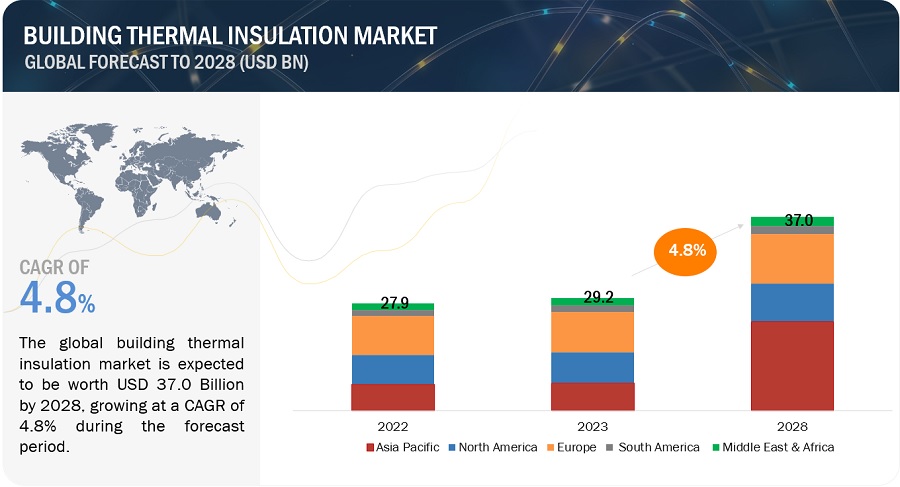
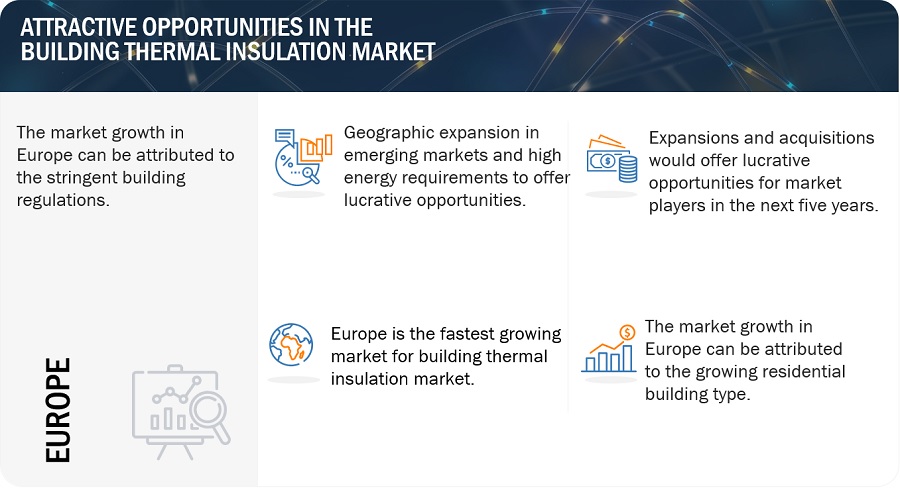
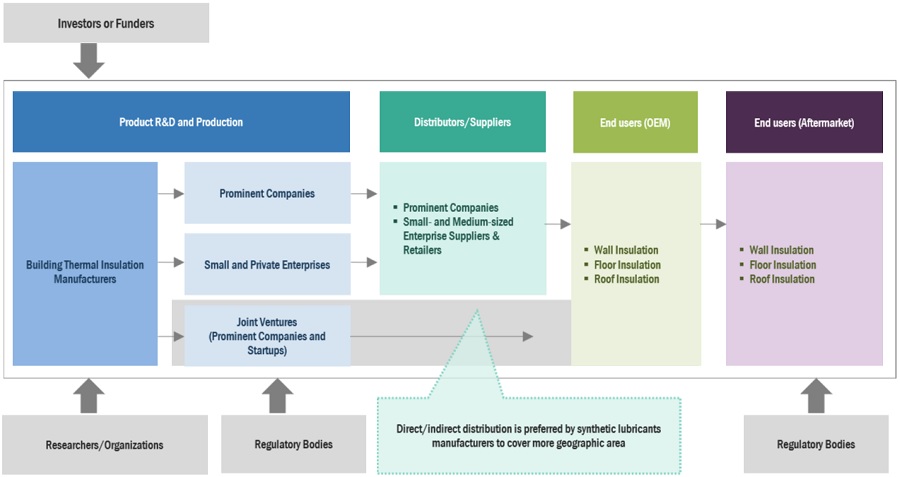
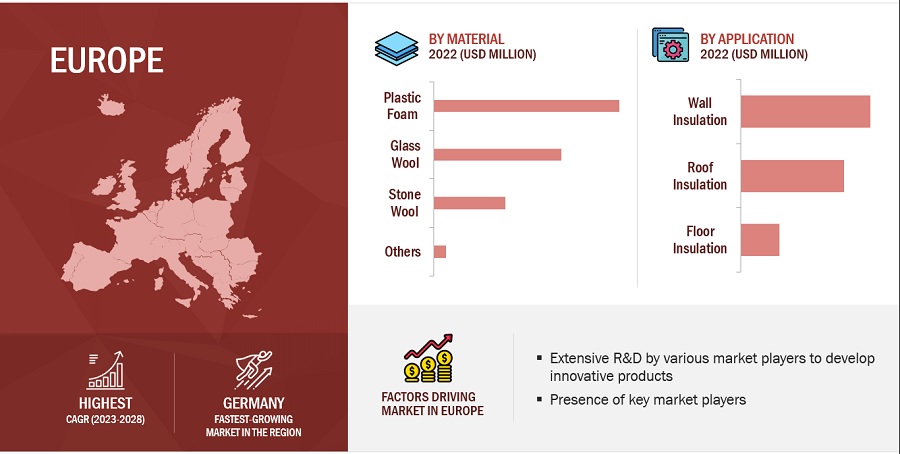
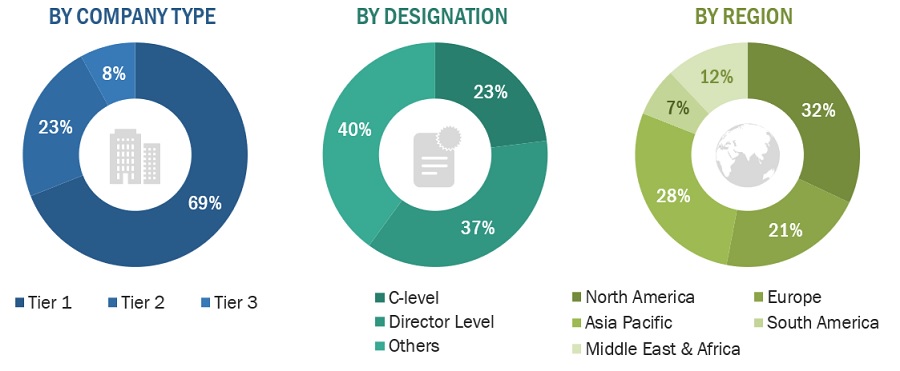
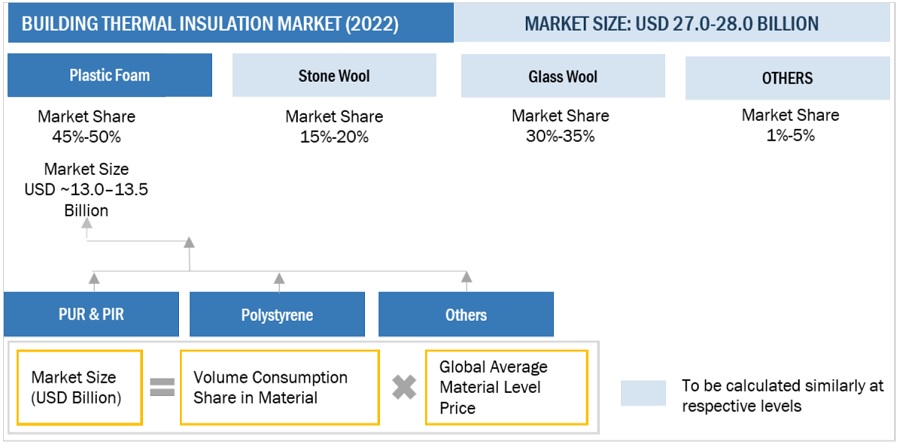
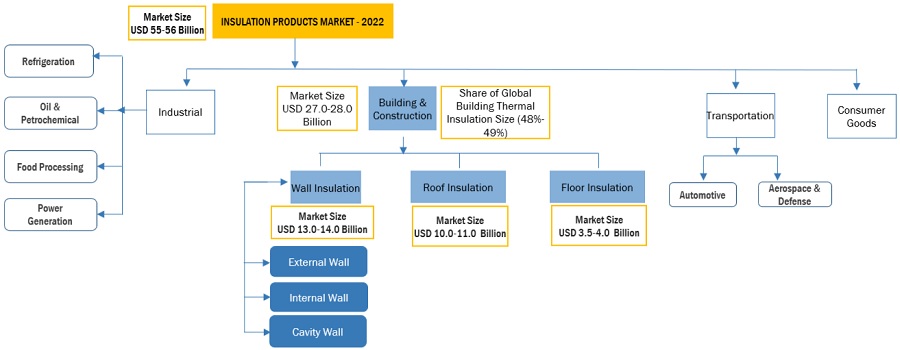



 Generating Response ...
Generating Response ...







Growth opportunities and latent adjacency in Building Thermal Insulation Market